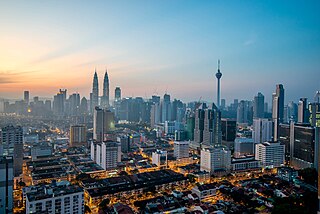Kuala Lumpur, the vibrant capital of Malaysia, encapsulates the country’s rich diversity through its architecture, cuisine, and multiethnic community. Known affectionately as KL, the city offers a harmonic mix of historical monuments and modern skyscrapers, including the famous Petronas Twin Towers. Visitors are treated to a cultural mosaic with bustling street markets, lush parks, and expansive shopping districts. Each corner of Kuala Lumpur promises a fascinating blend of traditions and contemporary life, making it a must-see destination for travelers seeking a unique urban experience in Southeast Asia.
Before you travel, research local festivals and events. Participating in these can greatly enrich your experience of Kuala Lumpur’s cultural heritage and vibrant community life.
Consider exploring beyond the city center to areas like Batu Caves and the National Zoo. These destinations offer unique insights into Malaysia’s natural and cultural richness.
Top things to do & see in Kuala Lumpur
Select the following sights and activities to discover best tickets and tours available in Kuala Lumpur.
Kuala Lumpur: The Heartbeat of Malaysia
| Country | Malaysia |
| Time in Kuala Lumpur | GMT+8 |
| Language spoken | Malay (Bahasa Malaysia) |
| Population | 1.808 million (Source: World Population Review) |
| Currency | Malaysian Ringgit (MYR RM) |
| Airports |
|
Kuala Lumpur, the vibrant capital city of Malaysia, stands as a testament to Malaysian culture, history, and modern growth. Known for its dazzling cityscape, the Petronas Twin Towers dominate the skyline, a symbol of rapid modernization. It’s a city that embraces its past as much as it presses forward, housing countless historic temples and mosques alongside bustling shopping malls and street markets.
Where is Kuala Lumpur?
Kuala Lumpur is situated in the heart of the Malaysian peninsula, nestled within lush rainforest terrain.
Distances:
| Route | Distance by car | Time by car |
|---|---|---|
| Penang to Kuala Lumpur | 220 miles (354 km) | Approximately 4 hours |
| Johor Bahru to Kuala Lumpur | 197 miles (317 km) | Approximately 3 hours 30 minutes |
What is Kuala Lumpur famous for?
Kuala Lumpur is famous for its impressive skyline highlighted by the Petronas Twin Towers, vibrant food scenes, and an assortment of cultures and traditions blending seamlessly within the city limits.
History
1850s-1890s: Early Beginnings
Kuala Lumpur, now the vibrant capital of Malaysia, began as a modest mining settlement in the 1850s. This era marks the discovery of tin by local miners in the confluence area of the Klang and Gombak Rivers, a pivotal point that attracted a wave of prospectors. The initial communal setup primarily comprised of Malay inhabitants, with a significant influx of Chinese workers brought in to expedite the mining process. This blend of cultures shaped the early social fabric of the area.
1900s-1957: Colonial Influence and Growth
Under British colonial rule in the early 20th century, Kuala Lumpur underwent significant changes. The administration designated it as the capital of the Federated Malay States in 1896, leading to rapid urbanization. This period saw the construction of notable buildings, laying down the administrative and commercial foundations of the modern city. The blending of colonial architectural styles with local designs became prominent, influencing the city’s aesthetic and cultural landscape.
1957-1990s: Post-Independence Expansion
Following the independence of Malaya in 1957, Kuala Lumpur continued to thrive as a federal capital. The era was marked by substantial infrastructure development, including the establishment of the University of Malaya and the completion of the National Mosque. The city’s growth accelerated due to its status as the country’s educational, cultural, and economic center. During these decades, Kuala Lumpur was molded into a more structured and significant metropolis, setting the stage for becoming a global city.
2000s-Present: Modern Metropolis
In the 21st century, Kuala Lumpur has transformed into a bustling, cosmopolitan city known for its skyscrapers, notably the iconic Petronas Towers, which were the tallest buildings in the world from 1998 to 2004. Today’s Kuala Lumpur is a major international tourism and business hub, reflecting a blend of modernity and traditional Malaysian cultures. The city’s ongoing development continues to draw global investments and tourism, promoting diverse cultural exchanges and economic growth.
Visit Kuala Lumpur
What to see and do in Kuala Lumpur
Exploring Kuala Lumpur offers a delightful blend of cultural, historical, and modern attractions:
- Petronas Towers: Marvel at the architectural brilliance of these twin skyscrapers.
- Batu Caves: Visit this limestone hill featuring temples and caves significant to the Hindu culture.
- Masjid Jamek: Experience the serene and spiritual ambience of one of the oldest mosques in the city.
- Central Market: Shop for traditional crafts and savor local Malaysian flavors.
- KLCC Park: Enjoy nature and leisure activities in the heart of the city.
Festivals and Events in Kuala Lumpur
Kuala Lumpur hosts a variety of cultural and arts festivals throughout the year:
- Thaipusam (January/February): Witness the colorful procession and the devotees fulfilling their vows.
- Kuala Lumpur Fashion Week (August): Catch the latest trends and fashion showcases by local and international designers.
- Malaysia International Gourmet Festival (October): Indulge in gastronomic delights from top chefs around the country.
Best time to visit Kuala Lumpur
The ideal time to visit Kuala Lumpur is between May to July or from December to February, when the weather is comparatively drier and pleasant, offering favorable conditions for exploring the city.
Is Kuala Lumpur worth visiting?
Kuala Lumpur is undoubtedly a destination worth visiting, with its dynamic mix of modern skyscrapers, vibrant street markets, lush green spaces, and rich cultural heritage. However, visitors should be prepared for its humid climate and bustling city life, which might not appeal to everyone. Despite these challenges, the city’s diverse attractions and culinary delights provide a rewarding experience for those seeking to explore Southeast Asia’s urban culture.









